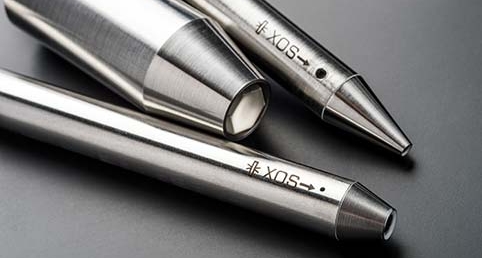- Analyzers
- Optics & Sources
- Technologies
- Support
- About
Control Plating Thickness with Polycapillary Optics
Introduction
The concept of polycapillary optics was introduced in the early 1990’s. Over the next two decades, XOS and a few other groups around the world conducted extensive research and development to significantly improve the optic manufacturing process. As a result, XOS became a leading global manufacturer of high-performance X-ray polycapillary optics and excitation systems.
In the research industry, initial applications were primarily focused on material analysis, among which micro X-ray fluorescence (micro-XRF) is the most popular and successful. Compared to conventional XRF analysis where a pinhole collimator is typically used to obtain a small X-ray beam size, the X-ray flux density of the excitation beam obtained by a polycapillary optic is typically two to three orders of magnitude higher. This performance boost of the excitation beam is a game changer for micro-XRF analysis.
Nearly all modern, high-performance micro-XRF instruments in the market are equipped with polycapillary X-ray optics. Combined with the evolution of other key technologies in XRF analysis (e.g. microfocus X-ray source and high-speed X-ray detector), the high-speed composition measurement and high-resolution elemental mapping become possible and are widely used for a variety of applications in the micro-electronics, automobile, life science, forensics, and art conservation industries.
Measuring Plating Thickness with XRF
One of the most successful industrial applications of the polycapillary optic technology is for plating thickness measurements on small electronic components and features. XRF is the most commonly used technique in plating thickness measurement as it is simple, fast, and non-destructive. With the electronic components getting smaller and more complex, it becomes nearly impossible for a conventional XRF instrument, typically equipped with a pinhole collimator, to achieve precise results in a timely manner due to the low excitation X-ray intensity. The practical limitation on the feature size that a conventional XRF instrument can measure is around 0.1mm, in addition to long measurement time.
Measuring and controlling the plating thickness has a significant economic impact on electronic component manufacturers. The plating thickness must meet a minimum requirement to optimize the functionality and performance of the components. Failure to capture any under-coated components in the early stages of the manufacturing process can result in costly scrap and rework. Without fast and reliable plating thickness measurement instruments, most manufacturers would choose to apply an overcoating to their components as a safety countermeasure. However, the increased material cost of coating materials, such as gold, nickel, and palladium, is very expensive.
Improve Precision and Reduce Cost with Polycapillary Optic Powered Instruments
A polycapillary X-ray optic can focus X-rays to less than 10 microns, making it possible to measure ultra-fine features on connectors, micro-electronics, wafers, lead frames, and complex circuit boards. Simultaneously, the high output beam intensity produced by the optic allows for a high-count rate of the XRF signal, leading to enhanced precision and quick measurement time. An electronic component manufacturer equipped with a polycapillary optic enabled, micro-XRF instrument will be able to improve measurement, control the plating thickness of their products and reduce cost by eliminating the overcoat. The cost savings incurred from the use of a polycapillary optic enabled instrument is the reason for the rapid growth of the high-end micro-XRF instruments.

CONCLUSION
XOS’ polycapillary optics combine a small focal spot and high X-ray throughput that allow users to test new applications that would be very difficult to accomplish for conventional XRF methods. The advancement of this technology has also been a driving force for the developments of other key components in an XRF system, such as the microfocus X-ray source and high-speed silicon drift detector (SDD). XOS is a global leader in polycapillary optic technology and will continue to collaborate with the X-ray research community and various industries to pursue new application opportunities.

